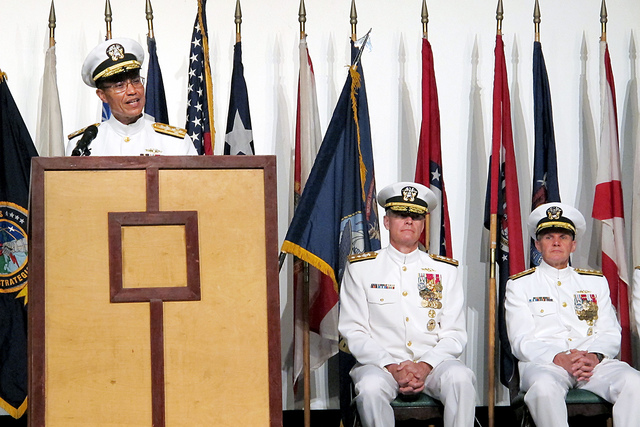PEARL HARBOR — The U.S. Navy on Thursday installed a new commander to lead its submarine force in the Pacific at a time when growing Chinese operations in places like the South China Sea are boosting U.S. demand for the
PEARL HARBOR — The U.S. Navy on Thursday installed a new commander to lead its submarine force in the Pacific at a time when growing Chinese operations in places like the South China Sea are boosting U.S. demand for the eavesdropping capabilities of the underwater vessels.
Rear Adm. Frederick Roegge, who most recently served in the Pentagon, took over from Rear Adm. Phillip Sawyer during a ceremony at Pearl Harbor initially scheduled to be held in front of a submarine at a pier but moved to a theater indoors because of heavy rain. Sawyer is becoming deputy and chief of staff for the U.S. Pacific Fleet, which has its headquarters just across the road, and he will stay in Hawaii.
The ceremony’s guest speaker, Adm. Cecil Haney, a former submarine commander himself and currently the commander of U.S. Strategic Command, said significant disagreements and disputes challenge peace and stability in the Pacific.
“For example, we see China’s efforts to assert regional dominance in the East and South China Seas while at the same time they’re operating a new ballistic missile submarine force, modernizing its mobile and fixed intercontinental ballistic missiles and conducting persistent cyber activities and counter space demonstrations,” Haney said.
China has become more active in asserting its territorial claims, including reclaiming land to build new islands at a number of disputed Spratly reefs in the South China Sea. Several of China’s neighbors also claim the reefs — including U.S. ally the Philippines — which lie in one of the world’s busiest shipping routes and are rich in fish and potential gas and oil reserves.
The U.S. has a policy of not taking sides in the territorial disputes, but it has declared it has a national interest in ensuring freedom of navigation and overflights.
The submarine force, which often called the “silent service,” plays an important role in keeping track of China’s increased activity.
“There’s only one type of intelligence gathering system that is really well-suited to listening in on the Chinese. That’s the submarine. They don’t know it’s there, but it can be very close to places like Shanghai,” said Loren Thompson, a defense analyst at the Lexington Institute, an Arlington, Virginia-based think tank.
Intelligence gathering is the single most important mission for the Pacific Fleet’s submarine force, Thompson said.
Submarines play an important role in preventing disputes like those in the South China Sea, as well as another territorial dispute in the East China Sea between China and another U.S. ally, Japan, from “getting out of hand,” said Eric Wertheim, an author at the U.S. Naval Institute in Annapolis, Maryland.
“Because any enemy force that would operate against us doesn’t know where the submarines are. And if you don’t know where the submarines are, they’re going to be a threat to your military forces,” Wertheim said.



